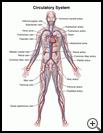
Angiogram
________________________________________________________________________
KEY POINTS
- An angiogram is a series of X-rays with contrast dye used to look for narrowing, weakness, or blockages in blood vessels.
- Plan for your care and a ride home after the procedure. You may also need to stay overnight.
- Your provider will tell you when you will get test results, and what symptoms or problems you should watch for and what to do if you have them.
________________________________________________________________________
What is an angiogram?
An angiogram is a series of X-rays taken after your healthcare provider injects contrast dye into your blood vessels to look for narrowing, weakness, or blockages in blood vessels.
When is it used?
Angiograms are done to check for problems in blood vessels. For example, your healthcare provider can see where an artery is blocked and how much is blocked. The results can help your provider see if you need treatment to widen an artery, remove a blockage, or bypass an artery.
What are the most common kinds of angiograms?
- Carotid angiogram. This test looks at your carotid arteries, which are on each side of your neck. They carry blood to the brain. A carotid angiogram can help your provider check for problems that increase your risk for stroke.
- Cerebral angiogram. This test looks at the blood vessels in your brain.
- Coronary angiogram. This test looks at the blood vessels that carry blood to your heart muscle. This helps your provider check for problems that increase your risk for a heart attack.
- Aortic angiogram. This test looks at the aorta, which is the largest blood vessel in your body. It carries blood from your heart to the rest of your body. An angiogram can show if your aorta is blocked or if there is a weak area that could cause bleeding or death.
- Peripheral angiogram. This test checks for problems in blood vessels in your legs, feet, arms, or hands.
- Renal angiogram. This test checks for problems in the blood vessels that carry blood to your kidneys.
How do I prepare for this procedure?
- Plan for your care and a ride home after the procedure. You may also need to stay overnight.
- You may or may not need to take your regular medicines the day of the procedure. Tell your healthcare provider about all medicines and supplements that you take. Some products may increase your risk of side effects. Ask your healthcare provider if you need to avoid taking any medicine or supplements before the procedure.
- Tell your healthcare provider if you have any food, medicine, or other allergies such as latex, contrast dye, or shellfish.
- Your healthcare provider will tell you when to stop eating and drinking before the procedure. This helps to keep you from vomiting during the procedure.
- Follow your provider's instructions about not smoking before and after the procedure. Smokers may have more breathing problems during the procedure and heal more slowly. It’s best to quit 6 to 8 weeks before surgery.
- Follow any other instructions your healthcare provider gives you.
- Ask any questions you have before the procedure. You should understand what your healthcare provider is going to do. You have the right to make decisions about your healthcare and to give permission for any tests or procedures.
What happens during the procedure?
The test is usually done in the hospital.
Before the test you will be given medicine to help you relax, but you will be awake during the test. You will be given a local anesthetic to numb the area where the catheter will be inserted. You may also be given medicine to help prevent blood clots.
Your healthcare provider will put a small tube called a catheter through your skin and into a blood vessel in your groin, arm, or neck. The catheter will be passed though the blood vessel and into the artery being checked. Contrast dye will be put into the artery and you may feel a warm or hot flush spreading over your body for a few seconds when the contrast dye is given. X-rays will be taken as the contrast dye moves through your artery. X-rays will show if there is a blockage, narrowing, or problem with the artery.
At the end of the test, your healthcare provider will remove the catheter and put pressure on the area where the catheter was put in (the puncture site) to control any bleeding. The test usually takes about an hour.
What happens after the procedure?
After the procedure you may stay in a recovery area for at least a few hours or overnight, depending on what was done during the procedure. The puncture site may be bruised and sore for a few days.
Ask your healthcare provider:
- How and when you will get your test results
- How long it will take to recover
- If there are activities you should avoid and when you can return to your normal activities
- How to take care of yourself at home
- What symptoms or problems you should watch for and what to do if you have them
Make sure you know when you should come back for a checkup. Keep all appointments for provider visits or tests.
What are the risks of this procedure?
Every procedure or treatment has risks. Some possible risks of this procedure include:
- You may have problems with anesthesia.
- You may have infection, bleeding, or blood clots.
- Other parts of your body may be injured during the procedure.
- In rare cases, you may have an allergic reaction to medicines used during the procedure.
- The test can cause irregular heart rhythms, which might need treatment.
- While not common, a heart attack or stroke might be triggered by the test.
Ask your healthcare provider how these risks apply to you. Be sure to discuss any other questions or concerns that you may have.

